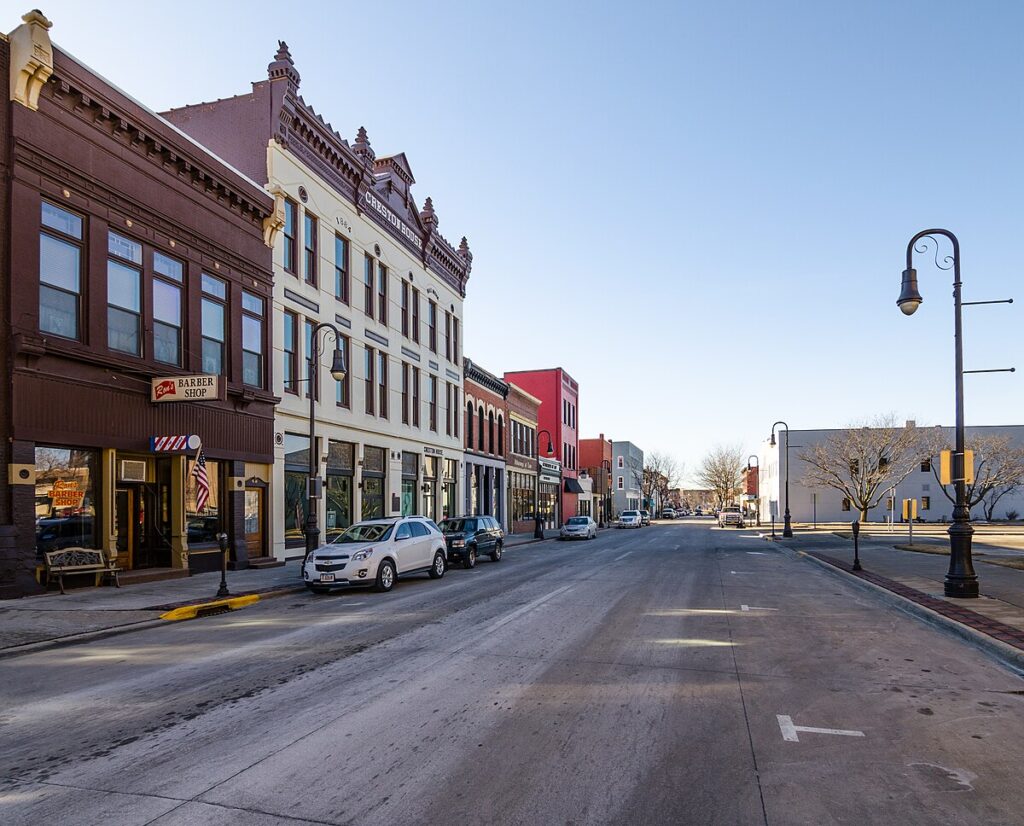
Moving to Council Bluffs, Iowa: A Comprehensive Relocation Guide
Considering moving to Council Bluffs, Iowa? This historic Omaha neighbor offers affordable living, casino entertainment, and Iowa tax advantages. With approximately 63,000 residents in 2025 (Omaha metro 967,000+), Council Bluffs combines Missouri River location with Omaha access and Southwest Iowa’s largest city.
Demographic Profile to Consider If Moving to Council Bluffs:
Council Bluffs’ 2025 population is approximately 63,000 residents in this Pottawattamie County seat along the Missouri River immediately across from Omaha, Nebraska. The median age is around 37 years, with working families, casino employees, and diverse residents. The population is approximately 85% White, 7% Hispanic, 4% Black or African American, 2% Asian. Council Bluffs features historic downtown, casinos providing entertainment and employment, residential neighborhoods, and serves as Iowa’s gateway to the Omaha metro. The city attracts working families seeking Omaha access with Iowa’s lower taxes, casino workers, and those wanting affordable metro living. Council Bluffs appeals to working-class to middle-class residents prioritizing value and Omaha proximity. The community balances historic character with casino economy and serving as Omaha’s Iowa suburb. Find trusted local services for moving, living, and working in Council Bluffs.Council Bluffs Relocation Directory
Cost of Living to Consider If Moving to Council Bluffs:
Council Bluffs offers exceptional affordability for Omaha metro access. Median home values range from $150,000 to $220,000 in 2025, significantly lower than Omaha while providing metro access and Iowa’s tax advantages. The median household income is approximately $55,000. Rental properties average $800 to $1,200 monthly. Iowa has no state income tax on retirement income; individual income tax is progressive 0.33%-8.53% (Nebraska has 2.46%-5.84% income tax). Property taxes are moderate. Overall cost of living is very low for Omaha metro access, making Council Bluffs highly attractive for working families, those seeking Iowa residency benefits, and casino employees. The city provides tremendous value with immediate Omaha access. Housing costs create exceptional accessibility with Iowa’s tax advantages over Nebraska residence.
Economy and Job Market:
Council Bluffs’ economy includes casinos, manufacturing, logistics, and retail. Major employers include Horseshoe Casino, Harrah’s Casino, Ameristar Casino providing gaming employment, Google data center, ConAgra, Union Pacific operations, and distribution centers capitalizing on I-80 location. Many residents work in Omaha (immediately across the river) or throughout the metro. The broader Omaha metro offers vast opportunities. Typical commute times to downtown Omaha are 15-25 minutes. The casino presence provides significant employment. Many residents work in gaming, logistics, manufacturing, and services throughout the metro.
Education:
Council Bluffs Community School District serves city students with schools including Abraham Lincoln High School and Thomas Jefferson High School. School quality varies requiring family research. Iowa Western Community College provides higher education and vocational programs. The educational infrastructure serves the working-class community with quality varying by school.
Recreation and Lifestyle:
Council Bluffs offers three major casinos (Horseshoe, Harrah’s, Ameristar) providing entertainment, dining, and gaming. The city features historic Squirrel Cage Jail (unique rotary jail museum), Historic General Dodge House, and Lewis and Clark Monument. Lake Manawa State Park provides recreation. Residents enjoy immediate Omaha access (5 miles) for entertainment, dining, sporting events (Creighton basketball, College World Series), and cultural attractions. The lifestyle emphasizes affordable living, casino entertainment, working-class values, and Omaha metro access. The four-season climate enables varied activities. The community values affordability, casino employment, historic preservation, and Iowa residency benefits. Living in Council Bluffs means accepting working-class character, casino-influenced economy, being Omaha’s less affluent neighbor, and some urban challenges while enjoying exceptional affordability, Iowa’s lower taxes versus Nebraska, casino entertainment, and immediate Omaha access creating the metro’s most affordable option where Iowa tax advantages meet casino economy.
Healthcare and Services:
Council Bluffs residents access healthcare through CHI Health Mercy Council Bluffs, Methodist Jennie Edmundson Hospital, and immediate access to Omaha’s extensive medical facilities including the Nebraska Medical Center. The regional healthcare infrastructure provides comprehensive medical care.
Transportation:
Council Bluffs is accessed via Interstate 80, Interstate 29, U.S. Route 6, and various corridors at a major transportation crossroads. Eppley Airfield (Omaha airport) is 15 minutes northeast. Metro Area Transit provides bus service. Most residents use personal vehicles. The Missouri River bridges connect to Omaha. Typical commute times to downtown Omaha are 15-25 minutes.
Conclusion:
Moving to Council Bluffs in 2025 offers affordable Omaha metro living with casino entertainment, Iowa tax advantages, and Missouri River location. The city’s combination of exceptionally low housing costs, Iowa residency benefits, and immediate Omaha access makes it ideal for working families, casino employees, and those seeking the Omaha metro’s most affordable option where Iowa taxes meet casino economy and exceptional value defines the metro’s gateway city.

